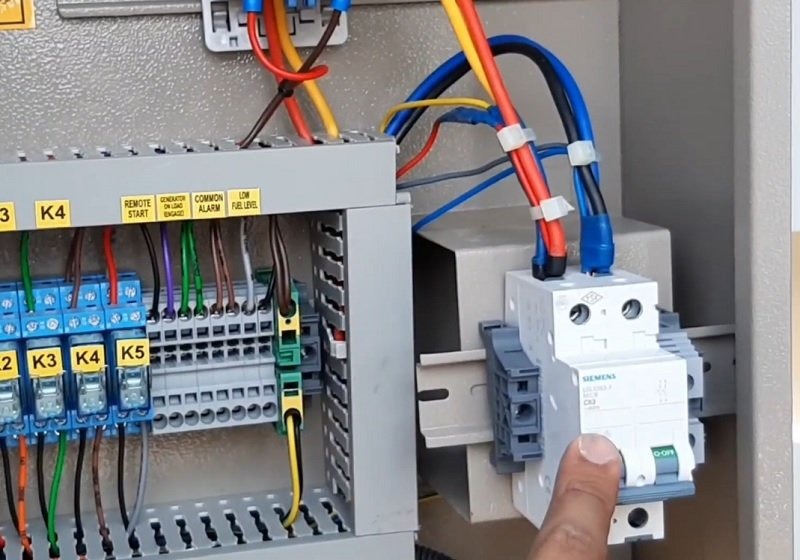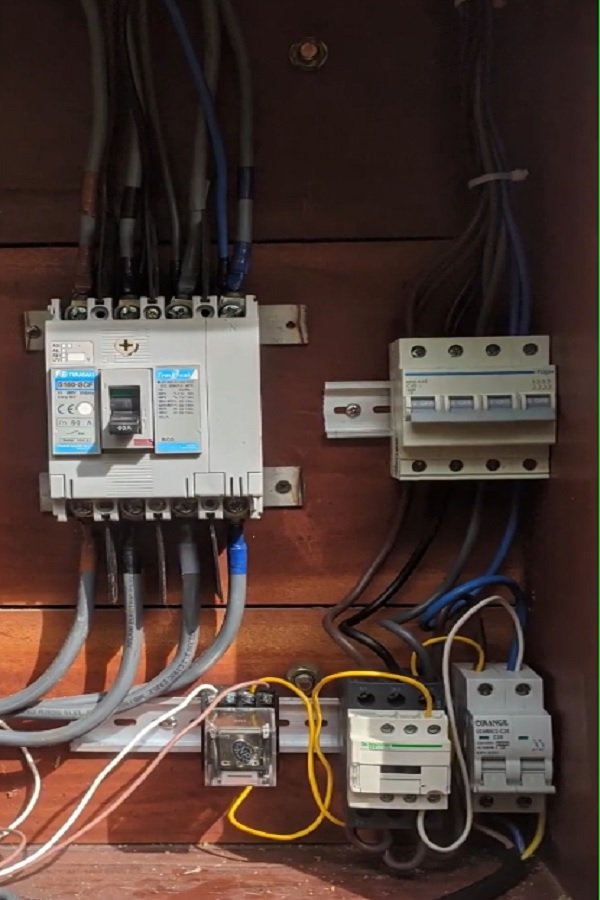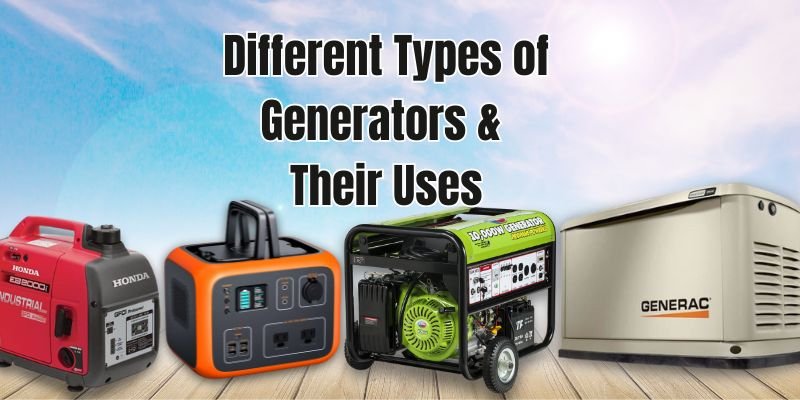Disclosure: This post contains affiliate links and I will be compensated if you make a purchase after clicking through my links. Learn More
To convert a 3-phase generator to single-phase 220V, reconfigure the generator windings and use a phase converter. Consult a professional for safety.
Many people face the challenge of converting a 3-phase generator to single-phase 220V to power household appliances or specific equipment. This process involves altering the generator’s electrical configuration to deliver the desired voltage. Understanding the steps and precautions is crucial for ensuring the safety and functionality of the generator.

Reconfiguring the windings and using a phase converter are essential methods to achieve this conversion. Proper guidance and professional assistance can make this task manageable and effective, allowing for optimal use of your generator in various settings.
Introduction To 3 Phase Generators
Three-phase generators are powerful machines. They produce electricity for large applications. Many industries rely on them. These generators offer balanced power distribution.
Basics Of 3 Phase Generators
Three-phase generators have three alternating currents. Each current is 120 degrees out of phase with the others. This setup creates a continuous power flow. It reduces power pulsations. This is essential for smooth operations.
Stator and rotor are key parts. The stator remains stationary. The rotor moves inside the stator. When the rotor spins, it generates electricity.
Common Uses And Applications
Three-phase generators are versatile. They are used in various fields. Here are some common applications:
- Manufacturing Plants: Power heavy machinery.
- Hospitals: Ensure reliable power supply.
- Data Centers: Keep servers running.
- Construction Sites: Power tools and equipment.
- Commercial Buildings: Support HVAC systems.
Industries depend on three-phase generators for continuous power. They ensure operations run smoothly. They are crucial in emergency situations.
Reasons To Convert To Single Phase
Converting a 3-phase generator to single-phase 220V can be beneficial. It helps improve efficiency and meet specific power needs. Understanding the reasons for conversion can guide you better.
Advantages Of Single Phase 220v
Single phase 220V offers multiple advantages. These include ease of use, cost savings, and compatibility.
- Ease of Use: Single-phase systems are simpler to operate.
- Cost Savings: They require less complex wiring and components.
- Compatibility: Most household appliances use single-phase power.
A single-phase system also requires less maintenance. This makes it ideal for residential and small commercial setups.
Scenarios For Conversion
There are various scenarios where converting to single-phase is beneficial. Some of these scenarios include:
- Residential Use: Most homes use single-phase power for their appliances.
- Small Businesses: Shops and offices often require single-phase power.
- Remote Locations: Single-phase systems are easier to set up in remote areas.
Understanding these scenarios can help you decide if conversion is right for you.
Safety Precautions
Converting a 3-phase generator to single phase 220V can be risky. Safety must come first. Follow these precautions to ensure a safe conversion process.
Personal Protective Equipment
Wear the right Personal Protective Equipment (PPE) for electrical work. This includes:
- Insulated gloves to protect your hands.
- Safety goggles to shield your eyes.
- A face shield for extra face protection.
- Insulated boots to prevent electric shocks.
Electrical Safety Guidelines
Adhering to electrical safety guidelines is crucial. Follow these steps:
- Turn off the generator before starting any work.
- Ensure the generator is disconnected from the power supply.
- Use a voltage tester to confirm no live wires are present.
- Follow the wiring diagram for correct connections.
- Keep your workspace dry and clutter-free.
- Avoid using metal tools near live circuits.
| Task | Safety Measure |
|---|---|
| Wearing PPE | Insulated gloves, goggles, face shield, boots |
| Checking for live wires | Use a voltage tester |
| Disconnecting power | Ensure no power supply before starting |
Tools And Materials Needed
Converting a 3-phase generator to single-phase 220V is a technical process. It requires specific tools and materials to ensure success. Below is a comprehensive guide on the essential tools and required materials.
Essential Tools
Before starting the conversion process, gather the following essential tools:
- Multimeter: For measuring voltage and current.
- Screwdrivers: Flathead and Phillips for opening panels.
- Wire Strippers: To strip the insulation from wires.
- Wrenches: Various sizes for tightening and loosening bolts.
- Insulation Tape: For securing and insulating wires.
- Drill: For making necessary holes.
Required Materials
Ensure you have the following materials before you start:
- High-Quality Wires: To handle the electrical load.
- Capacitors: For balancing the load.
- Connectors: For connecting wires securely.
- Circuit Breaker: For safety and protection.
- Electrical Tape: For insulation and securing connections.
- Protective Gear: Gloves and goggles for safety.
Having these tools and materials ready will make your conversion process smoother and safer. Always prioritize safety and double-check each step.
Preparation Steps
Converting a 3-phase generator to single-phase 220V requires careful preparation. Proper preparation ensures safety and efficiency. Follow these preparation steps for a smooth conversion process.
Inspecting The Generator
Start by thoroughly inspecting the generator. Ensure it is in good condition. Look for any signs of wear or damage. Check all cables and connections. Ensure the generator is properly grounded. Verify there are no loose parts.
Use a multimeter to test the generator’s output. Check if all phases are working correctly. Document the voltage readings for each phase. Ensure the generator can handle the conversion.
Gathering Necessary Information
Gather all the necessary information before starting the conversion. Refer to the generator’s manual. Identify the generator’s power rating and phase configuration. Understand the wiring diagram.
List down all the tools and materials needed. You might need connectors, wires, and a voltmeter. Ensure you have everything before starting the conversion.
| Item | Description |
|---|---|
| Multimeter | For measuring voltage and continuity |
| Connectors | For connecting wires safely |
| Wires | For making electrical connections |
| Manual | For understanding generator specifications |
Ensure you understand the wiring process. Study the wiring diagram and connections. This will help you avoid mistakes during conversion.
Conversion Process
Converting a 3 phase generator to single phase 220V involves several key steps. This process requires careful attention to detail and safety precautions. Follow these guidelines to ensure a successful conversion.
Disconnecting The Generator
Before starting the conversion, you must disconnect the generator. Ensure the generator is turned off and disconnected from any power sources. Use insulated tools to avoid electric shocks.
- Turn off the generator.
- Disconnect all power cables.
- Ensure the generator is grounded properly.
Safety is crucial. Wear protective gear like gloves and goggles. Ensure no power flows through the generator before proceeding.
Rewiring For Single Phase

Rewiring the generator is the core part of the conversion. This step changes the electrical connections to support single-phase 220V output.
- Locate the generator’s wiring diagram.
- Identify the three-phase wires: typically labeled L1, L2, and L3.
- Connect L1 and L2 wires to the single-phase output terminals.
- Cap off the L3 wire; it won’t be used.
- Ensure all connections are tight and secure.
Double-check all connections to ensure they are correct. Use a multimeter to test the output voltage. Confirm it is 220V before using the generator.
Below is a simple table summarizing the key steps:
| Step | Action |
|---|---|
| 1 | Turn off the generator |
| 2 | Disconnect power cables |
| 3 | Ground the generator |
| 4 | Locate wiring diagram |
| 5 | Identify L1, L2, and L3 wires |
| 6 | Connect L1 and L2 to output terminals |
| 7 | Cap off L3 wire |
| 8 | Check connections and test voltage |
Follow these steps carefully to convert your 3 phase generator to single phase 220V. Always prioritize safety and accuracy.
Testing The Converted Generator
Once you’ve converted your 3-phase generator to single-phase 220V, testing is crucial. This ensures the generator operates safely and effectively. Below are the steps to follow for testing the converted generator.
Initial Power-up
Before starting, ensure all connections are secure. Double-check the wiring and connections to avoid short circuits or damage.
- Turn off all connected devices.
- Switch the generator to the “On” position.
- Start the generator and let it run for a few minutes.
During the initial power-up, listen for any unusual sounds. A smooth running engine indicates a successful conversion.
Voltage And Load Testing
Next, measure the voltage output using a multimeter. Set the multimeter to measure AC voltage.
- Connect the multimeter probes to the generator’s output terminals.
- Check for a steady 220V reading.
If the voltage is correct, proceed with load testing.
For load testing, gradually connect devices to the generator. Start with low-wattage appliances and monitor the generator’s performance.
| Device | Wattage |
|---|---|
| Light Bulb | 60W |
| Fan | 75W |
| Refrigerator | 150W |
Observe the generator’s behavior with each added load. Ensure the voltage remains stable at 220V. Listen for any signs of strain or irregularities.
If the generator handles the load without issues, your conversion is successful. Always prioritize safety during testing.
Troubleshooting Common Issues
Converting a 3 phase generator to single phase 220V can be tricky. Many encounter issues during the process. This section covers common problems and their solutions.
Identifying Wiring Problems
Wiring issues are common in generator conversions. Check all connections for any loose or damaged wires. Loose wires can cause power loss. Verify that all wires are in the correct terminals. Consult the generator’s manual for proper wiring diagrams. Use a multimeter to check for continuity in the wiring. Ensure all connections are secure and follow the correct path.
Addressing Power Fluctuations
Power fluctuations can damage appliances. They occur due to improper load balancing. Make sure the generator’s load is distributed evenly. Use a voltmeter to monitor voltage output. If the voltage is unstable, check the generator’s capacitor. Replace any faulty capacitors. Keep the generator well-maintained to avoid fluctuations.
Maintenance Tips
Maintaining a 3 Phase Generator converted to Single Phase 220V ensures long-term efficiency. Regular maintenance can prevent unexpected breakdowns and costly repairs. Follow these tips to keep your generator in top condition.
Regular Inspection
Regular inspection is crucial for your generator’s health. Check for loose connections and corroded wires. Inspect the fuel system for leaks. Verify that the cooling system is working properly. A simple visual check can reveal potential issues.
- Inspect for loose connections
- Check for corroded wires
- Examine the fuel system for leaks
- Verify the cooling system
Routine Servicing
Routine servicing keeps your generator running smoothly. Change the oil and filters regularly. Clean the air filters to ensure proper airflow. Test the battery and charge if necessary. Lubricate moving parts to reduce wear and tear.
| Service Task | Frequency |
|---|---|
| Oil Change | Every 100 hours |
| Filter Replacement | Every 200 hours |
| Battery Test | Monthly |
| Lubrication | Every 50 hours |
Follow these maintenance tips to keep your generator running efficiently. Regular inspection and servicing can extend your generator’s life. Always use quality parts for replacements.

Frequently Asked Questions
How Do You Convert A 3 Phase Generator?
Use a phase converter to change 3 phase to single phase.
Is It Safe To Convert A 3 Phase Generator?
Yes, if done correctly with appropriate equipment.
What Is The Cost Of Conversion?
The cost varies depending on the equipment and labor.
Can All 3 Phase Generators Be Converted?
Most can, but check the generator’s specifications first.
Final Words
Successfully converting a 3-phase generator to single-phase 220V can be a game-changer. It enhances flexibility and utility. Follow the steps carefully to ensure safety and efficiency. Always consult a professional if unsure. This process can significantly broaden your generator’s applications, making it a valuable asset.


